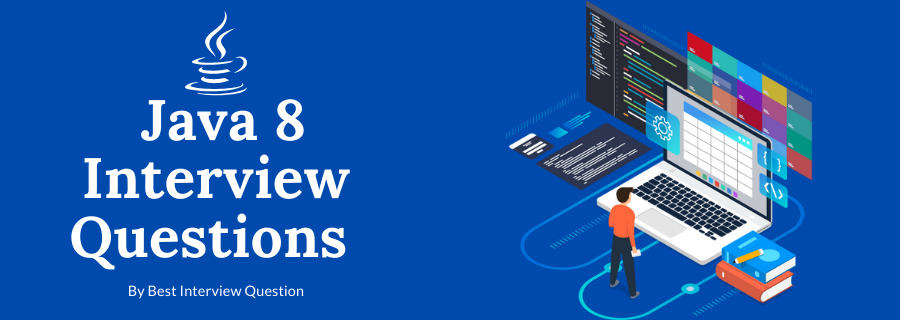Java 8 Interview Questions and Answers

JAVA is an open-source object-oriented programming language that is secure and robust. JAVA is the language that can run on all the platforms which support JAVA without recompilation. More than 3 billion devices run on Java. JAVA is used for developing Mobile applications, Desktop applications, Web servers, and application servers etc.JAVA was developed by James Gosling at Sun Microsystems now ORACLE in the year 1995.
The Java 8 interview questions we are mentioning below will help you to gain enough of the knowledge about Fortran.
- Introduction of Lambda Expression- first step to functional programming
- New stream API to supports pipeline processing.
- Optional − Emphasis on handling null values properly.
- Nashorn Engine- Provides better performance than Rhino javascript engine.
| JAVA 8 | |
|---|---|
| What is JAVA 8? | JAVA 8 is one of the versions of JAVA programming which was released on March 18, 2014. |
| Latest Version | Java SE 1317th September 2019 |
| Developed By | Sun Microsystems |
| Designed By | James Gosling |
Most Frequently Asked Java 8 Interview Questions
| S.no | Collection API | Stream API |
|---|---|---|
| 1. | Collection API is for storing the data in the different kinds of data structures. | Stream API is not a data structure; it is used for computation of the data on the big set of objects |
| 2. | A finite number of elements can be stored in a data structure | An infinite number of features can be stored |
| 3. | Consumption of elements is multiple times | Consumption of elements is only once. |
A Spliterator is a type of Java8 Iterator in java. util package that traverses and partitions the elements of a source in Java into another Spliterator. A source can be a collection or an IO channel or a generator function
Java 8 introduced a command tool jjs for the Nashorn to execute the javascript program codes at the console.
The Stream API is used to process a group of objects. A stream is a series of objects which supports different methods that can be pipelined to produce the expected result.
The features of the stream are –
- A stream takes the input from the Collections, an Arrays or the I/O channels.
- Streams don’t alter the original data structure; they only give the result according to the pipelined methods.
- Each intermediate operation is executed in a lazy manner, and as a result, it returns a stream. Hence various intermediate processes can be pipelined. The terminal operations remain at the end of the pipelining process. It replaces the final value, and the pipeline is terminated.
| S.no | Map | Flat map |
|---|---|---|
| 1. | For one input value, it gives one output value | For one input value,e it produces the arbitrary number |
Stream Pipelining is done by dividing the operations which can happen on the flow into two categories. The first is Intermediate operations and the second is Terminal operations. The common operations return the stream itself so that the result can be pipelined. The terminal operations remain at the end of the pipelining operation. It returns the final value, and the pipeline is terminated.
Random random = new Random();
random.ints().limit(15).forEach(System.out::println);
The code to print the count of empty strings in Java 8 is:-
List strings = Arrays.asList("abc", "", "bc", "efg", "abcd","", "jkl");
//get a count of empty string
long count = strings.p
arallelStream().filter(string -> string.isEmpty()).count();
Point to be noted: Go through this Q&A very thoroughly as this is one of the most asked java 8 interview questions.
List<String>strings = Arrays.asList("abc", "", "bc", "efg", "abcd","", "jkl");
int count = strings.stream().filter(string −> string.isEmpty()).count();
Parallel streams divide the provided venture into many and run them in unique threads, making use of a couple of cores of the computer. On the other hand, sequential streams work just like for-loop the use of a single core. The duties supplied to the streams are generally the iterative operations performed on the factors of a series or array or from different dynamic sources. Parallel execution of streams run more than one iterations concurrently in extraordinary accessible cores.
Collectors perform the reduction operations. It combines the result of the processing ongoing on the elements of the stream like collecting the elements into collections, summarizing the elements according to the different criteria. Collectors return the list or a string. As a result, the readability is increased. Static import used here is static import java.util.stream.Collectors.*;
What is JAVA 8?
JAVA 8 is one of the versions of JAVA programming language which was released on March 18, 2014. Java8 provides supports for functional programming, new JavaScript engine Nashorn, new APIs for the date and time manipulation, new streaming API, etc. Now the coding has become simple.